When at death the soul departs from the body the information gathered during life in the form of karmas is carried in the karmic body,[50] which together with the “fire” or rather electric body,[51] accompanies the soul when it leaves the physical body The connection between these two bodies has always existed and always will exist - an absolute beginning is denied in Jainism - and every soul has these two invisible bodies. There is only modification during incarnation. These bodies do not leave the soul until complete liberation or nirvāna is reached, because then any karmas cease to adhere to the pure soul.
It is the karmic body, which determines the nature of the next birth. The next birth takes place exceedingly rapidly according to Jainism, in “less than the winking of an eye.” As soon as the soul is freed from the physical body it flies at incredible speed and in a straight line to the destination determined by its accompanying karma. This does not mean that the soul resumes a physical body at once. Depending on karma physical incarnation may take place quickly, or in the near or even very distant future. The jīva may than be reborn in the body of a human or any other living being, including both visible and invisible beings, trees, plants, and animals, depending on the ethical values - good or bad - practiced in the past.
It may seem strange to the reader that the soul of a former human being might be reborn in a plant body or any non-human creature. For example, due to its particular karmas a soul may be drawn first to embodiment in the soil of the earth and then be transferred by its karma to the sprouting seed of a tree. In the case of the human soul, this seems to refer to the process of transmigration of particular aspects of the soul through various stages between two human existences, rather than to an actual loss of humanness (or “animalness” or “plantness” etc. as the case may be) or other higher qualities.
Modern biology teaches us that “we” first go through a unicellular ovum stage, and then through a sequence of embryological stages which among other things show similarity with a sea urchin, a fish, a then a tailed vertebrate; a newborn child hardly differs from the baby of a great ape as far as its mental capacities are concerned. As a child and adolescent we experiment once again which what humankind has already learned when in its more primitive stages. Our soul is involved in all stages of physical, emotional and mental growth, but is it possible to say when exactly we became “we”? If we - I mean our souls - pre-existed long before our present birth, we do indeed go in progressive sequence through a unicellular and maybe even a mineral stage, and then a plantlike stage and a primitive and evolved animal stage before the soul accomplishes its present human incarnation in full.
In the rich story tradition of the Jains, humans are almost always reborn as humans (after having spent some time in either heaven or hell), though animal incarnations do occur (in the stories) to work out a particular karma, followed by a return to human incarnation after some time. This happened, for example, in one of the former lives of the last Tīrthamkara, Mahāvīra, who incarnated as a lion, and in that situation became convinced of the need to adopt the pious attitude of non-violence.
Whether philosophically correct or not, the popular belief that we human souls may incarnate in any form, and therefore that any life-form may have been a human in the past, gives rise to a universal awareness of brotherhood for all creatures alike. An animal you kill may have been your human friend somewhere in the past. Would you have killed him then?
What is more important perhaps is that the theory of transmigration of the jīva through a variety of bodies in no way contradicts the theory of gradual evolution. It is most probable that a soul, which is clothed in a particular vehicle according to its karma, produces causes in line with its present state. The next embodiment (on earth) will then be related to the present one, but just a little bit higher, due to the inherent upward drive of the soul, and due to the added experiences. It is however next to unthinkable that great jumps upward would be made at once, simply because a soul in its present stage is unable to create the cause for a much higher karmic result. On the other hand, a great fall is also improbable, because that would mean the complete exhaustion of the karmas which brought us to our present state, as well as counteraction of all the karmas that were brought about in the present state. It is unimaginable that a higher being, such as a human, would at once and perhaps for ever lose all the merits - i.e. all the typical human faculties of sense development and mental and intuitive development - which have brought him to this situation, due to a few vibrations of a lower kind. It is more plausible that relatively small modifications take place from incarnation to incarnation, such as peculiarities of the human character or physical or psychological constitution, or small jumps from species to related species within the animal or plant kingdoms. The general rule would then be: once a human, always a human, at least for a long period of time; and once an animal, or plant, or mineral, always an animal, or plant, or mineral, until the time when the soul creates the cause for embodiment in a higher form. But, according to many Jains, intermediate incarnations may take place in lower realms, as a result of certain actions and attitudes that squander the human life by building up mountains of sins.
 Dr. Sneh Rani Jain
Dr. Sneh Rani Jain
 Publisher:
Publisher: